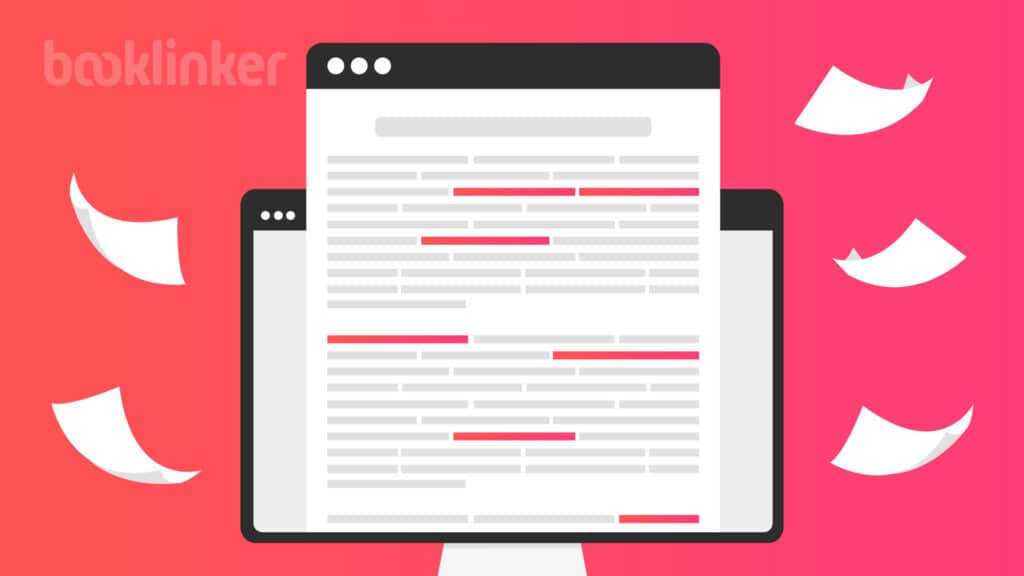
As an author or a publisher, you’re going to be doing a ton of book marketing in an attempt to direct readers to your book’s Amazon page.
Once readers arrive there, an author’s primary mission is to convert visitors into buyers.
There are several factors that influence this conversion rate, such as the book cover, title of your book, Amazon reviews, and lastly, your Amazon book description.
Getting your book description right is essential for maximizing your sales, which is why we had a chat with Charles Levin, founder of Munn Avenue Press, and author of the Not So Dead Series.
Charles has been writing copy for over 40 years, making him the perfect candidate to create this guide on how to write a high-converting Amazon Book Description.
Without further ado, let’s jump right into it!

Key Takeaways
- Importance of an Amazon Book Description: A well-crafted Amazon book description not only boosts sales but also improves the book’s organic ranking on Amazon, increasing visibility and potential sales.
- Unique Aspects of Nonfiction Descriptions: Nonfiction book descriptions should highlight the author’s credentials and clearly explain the unique benefits and practical value the book offers to potential readers.
- Unique Elements of Fiction Descriptions: Fiction book descriptions should include a captivating hook, a brief introduction to the protagonist and the central conflict, and comparisons to well-known authors or books to help readers understand the genre and style.
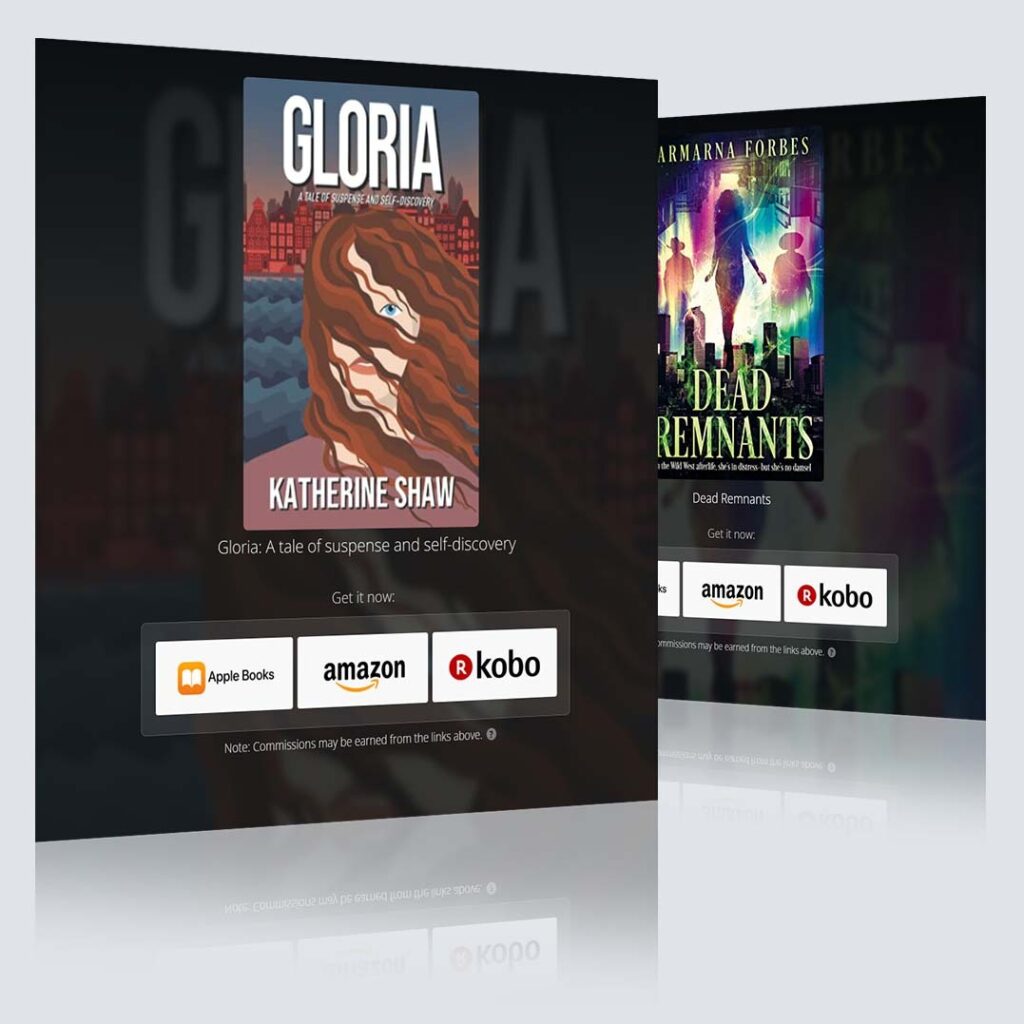
Free Universal Book Link Generator
- Increase book link CTR via custom vanity URLs
- Boost international sales by geotargeting readers
- Book store links update automatically based on book availability
- Advanced marketing analytics
Table of Contents
Importance of an Amazon Book Description
What most authors don’t realize is that after your book is published, you’re no longer an author.
You’re now a marketer.
And a book description is really just sales copy.
It goes without saying that an optimized Amazon book description will increase your sales, but did you know, it will also increase the organic rankings of your book in the Amazon algorithm?
Why?
Amazon’s organic search algorithm has several different data points it looks at, with the conversion rate (the number of readers who click on the book and buy it) of the product being one of them.
This also means an author with a poorly optimized book description will not sell as many as they could, leading to their book falling in the rankings and therefore, selling fewer books.
Now that you have an idea of just how important an Amazon book description is, let’s dive into some examples of how to create a high-converting description.
In order to best educate readers on this process, we’ll break the book description into several different components.
For the purposes of this guide, we’ll break it down into the following sections:
- The hook
- Follow-up sentences before “Read More”
- The body
- Conclusion and call to action
Example #1- Charles Levin - Not So Dead

The Hook
Charles always starts the first few lines of the description with a hook. It’s a short, punchy, one-sentence, usually a question, that will get people thinking.
For those engaged in the world of social media, you understand that short and punchy text gets attention. Readers have the same mindset when shopping for books. If the book description doesn’t grab them quickly, they won’t stick around.
In the Amazon book description of Charles Levin’s thriller “Not So Dead”, the opening line is:
“What if you could live forever, would you do it?”

According to Charles, there’s something about a question that bypasses people’s conscious filters, and goes directly to the unconscious, which causes them to want to work through the question. It’s not a voluntary thing. If somebody asks you a question, you can’t shut that off.
For this reason, starting your description with a powerful, intriguing, or ironic question is a great way to get people involved.
In the above example, people might be thinking to themselves:
“Well, what do you mean live forever?”
“Or what are you talking about?”
I’m gonna continue to read to find out.
Charles says that 90% of the authors that come to him for consulting services have a wall of words for their description.
If you get the hook wrong, the rest of the description is useless –No potential buyer will ever read it!
After you get the hook down, next comes the supporting follow-up text.
The Follow-Up (Still Before the ‘Read More’)
We have a few more lines to work with before we run into the “Read More” button.
If you have a powerful blurb, this is a great place to insert it, especially if it’s an endorsement from somebody that potential readers might know.
Continuing with the examples from his Not So Dead thriller, the blurb above the read more button is:
“There’s a cutting-edge current to every page that’s hard to resist, so get ready to engage your heart and your mind.” – Steve Barry, New York Times bestselling author.”
Steve Barry has sold about 25 million books so there are many readers that recognize his name.
If you don’t have a testimonial from a big name, don’t worry about it. Any name is better than no name. The human mind places a lot of value on others’ reviews during a buying process, even if it’s a stranger.
From here, the visitor has the choice to either click the read more button, click the buy button, or abandon the page.
You don’t want them to abandon the page, so hopefully, between your hook, blurb, title, cover, and reviews, you’ve convinced them to buy the book, or at the very least, keep learning more about your book and carry on to the body of the description.
Body of the Description
Now let’s go into detail on what comes after the visitor clicks the “Read More” button.
The body of the description will tell a potential reader a little bit more about what the book is about.
But not too much.
Keep in mind, we’re dealing with short attention spans here.
In Fiction, the reader wants to know:
“Who’s the protagonist?”
“What predicament do they find themselves in?”
So in this case, for Not So Dead, Charles writes:
“What could go wrong when a team of brilliant computer scientists achieves immortality by digitizing their personalities? Everything – if the government wants the technology and you’ve crossed paths with a band of ruthless terrorists bent on causing unspeakable damage.”
And then it goes:
“Follow Sam Sunborn as he teams up with a real Einstein to give birth to an invention that could change the lives of everyone on the planet forever.”
That should engage the reader, and get them thinking.
At this point, we’ve hooked the reader, backed it up with some social proof, and delivered the plot and protagonist in an intriguing way.
In fiction descriptions, it’s now time to make some comparisons. We’ll go over two non-fiction examples after.
If the reader doesn’t know who you are, how can you tell them what your writing is like?
You do this with comparable titles.
That’s why in Hollywood when people come in to pitch their movies, they’ll say “My screenplay is like a cross between Godzilla and 30 Girls 30 Days.”
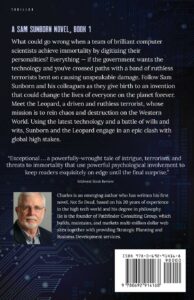
Or in the startup world, people will put in their pitch decks, “We’re like Uber for X.”
Human minds operate off pattern recognition, and we want to take advantage of this in our copy.
So, next in Charles’s description for Not So Dead, Charles writes:
“Not So Dead, is the first standalone book in the Sam Sunborn series of cutting-edge techno thrillers. If you like Michael Crichton, Tom Clancy, and Robert Ludlum, then you’ll love Not So Dead.”
It basically tells the reader, “If I like those authors (who are huge authors in Thrillers), then okay, maybe I will like this book.”
Of course, you should only make a comparison if it’s accurate.
Don’t just compare your book to the biggest in the genre so it’s recognized by as many readers as possible. It might work in the short term, but being an author is all about playing the long game and building trust.
This brings us to the last part of your description, the call to action.
Description Conclusion + Calls to Action
In Charles’s consulting practice, he notices almost none of the clients he works with include a call to action in their Amazon book descriptions.
Charles believes this is an enormous missed opportunity.
Assuming you’re not familiar with the terminology, a call to action in this context would be something like:
- “Buy my book today”
- “Get yourself a copy”
- “Find out more by reading”
That’s the general idea of a call to action, but you don’t have to make it so aggressive.
In Charles’s case for Not So Dead, he decided to go with:
“Buy Not So Dead and Plug into this exciting thrill ride today.”
Tip!
- A simple reminder for the reader to buy your book will massively increase your traffic conversion rate
There are just two elements left of Charles’s book description formula.
After the call to action, Charles includes another short little blurb reinforcing the entire description.
“A tense, high-powered techno-thriller” – Kirkus Review.
Many readers know Kirkus, as it’s been around a long time and is considered a trusted source with unbiased reviews.
Lastly, Charles added a one-sentence bio, in case people don’t scroll down to view the bio:
“Charlie’s 23-year background in tech, a degree in philosophy and love of fast-paced thrillers are the brew that created NOT SO DEAD. He lives in New Jersey with his wife, Amy, and has two sons, too far away in California.”
Note: he saves his more complete bio for his Amazon Author Page.
Now that we’ve taken a close look at Charles’s Fiction example, let’s take a look at two non-fiction examples from Charles’s client base.

Introducing: Booklinker Collections
One landing page for all your books. 100% free.
One link for easy sharing of your books across your backmatter, websites, emails, and social media.
Example #2 – Carrie Paul Handwritten Notes
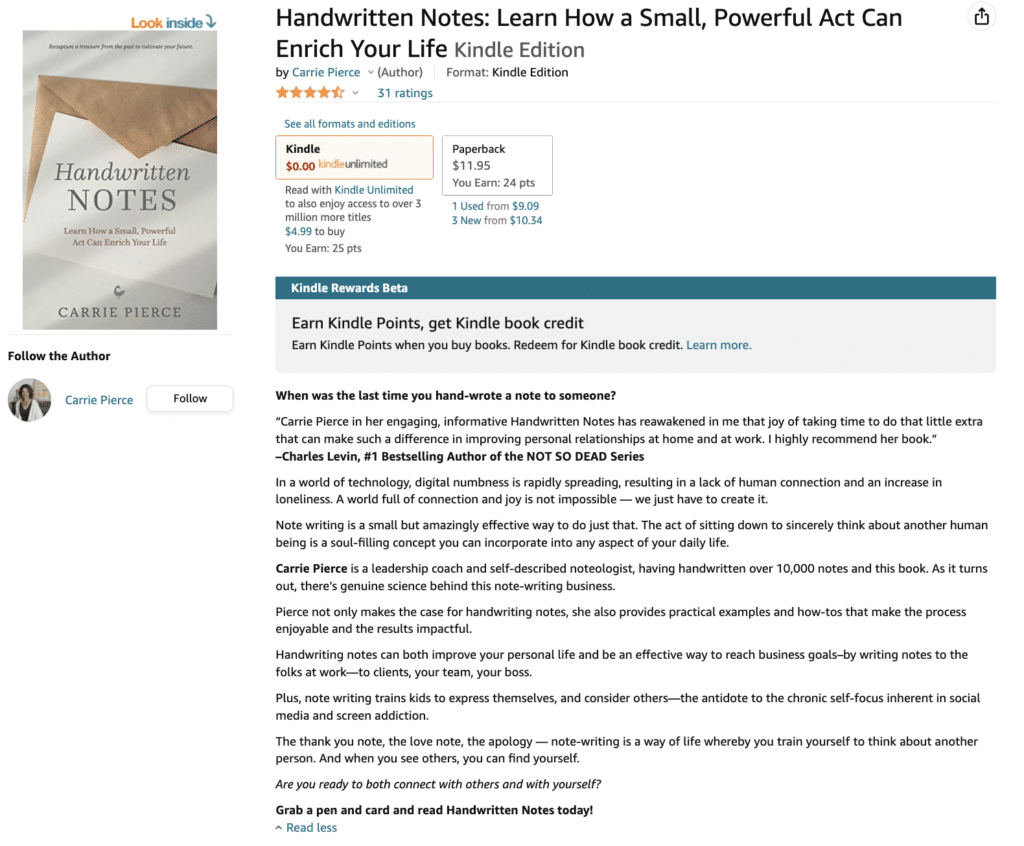
Next, we’re going to take a look at the book description for a book called Handwritten Notes. The author, Carrie Pierce, is obsessed, in a good way, with the power of handwritten notes.
The hook:
“When was the last time you hand-wrote a note to someone?”
It’s a pretty simple hook, that a lot of people will scratch their heads at because they can’t remember the last time they hand-wrote a note.
These days we are so keyboard and phone oriented.
It’s intriguing enough for the reader to think:
“What are you talking about?”
Next, the follow-up sentences before “Read More”
“Carrie Pierce in her engaging, informative, Handwritten Notes has reawakened in me that joy of taking time to do that little extra that can make such a difference in improving personal relationships at home and at work. I highly recommend her book.”
– Charles Levin, number one bestselling author of the Not so Dead series
Who wouldn’t click ‘Read More’ after that?
Tip!
- With non-fiction books, you always want to sell the potential reader on a practical “why this book.”
So Carrie follows up with:
“In a world of technology, digital numbness is rapidly spreading, resulting in a lack of human connection and an increase in loneliness. A world full of connection and joy is not impossible — we just have to create it.
Note writing is a small but amazingly effective way to do just that. The act of sitting down to sincerely think about another human being is a soul-filling concept you can incorporate into any aspect of your daily life.”
Another important aspect of non-fiction book descriptions is credentials. If a reader is about to spend money on life advice from someone, you’re going to want to make sure they’re qualified.
So in this case, there’s a sentence stating Carrie Pierce’s credentials:
“Carrie Pierce is a leadership coach and self-described noteologist having written over 10,000 notes.”
Let’s take a look at one more non-fiction example.
Example #3 – Katherine Ellison - Buzz
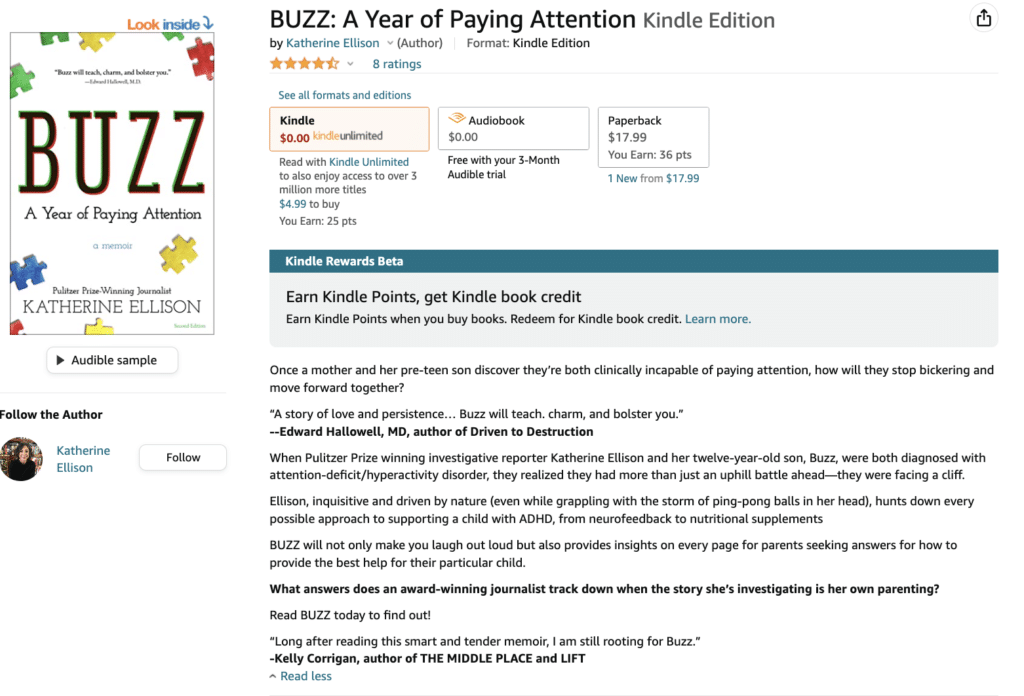
The last example we’ll take a look at is one from Pulitzer Prize-winning author Katherine Ellison. Katherine got her publishing rights back from Hachette and came to Munn Avenue Press where they went on to redo the cover, interior of her book and republish it as a second edition under the Munn Avenue Press imprint.
Katherine’s book, BUZZ, is an interesting memoir about how both her son and she have ADHD which created some real challenges for her family.
Katherine is an investigative reporter by trade and jumped to do the latest and greatest thing she could do to help her child, and wrote a one-year memoir on their experience.
Now that you have some background on Katherine and her book, the description leads with a hook:
“Once a mother and her preteen son discover they’re both clinically incapable of paying attention, how would they stop bickering and move forward together?”
Followed by a blurb from the foremost guy in this field:
“It’s a story of love and persistence. Buzz will teach charm and bolster you.”
– Edward Hollowell, MD Author of Driven to Destruction.
Next, a bit of proving her expertise comes right after it:
“When Pulitzer Prize-winning investigative reporter, Catherine Ellison and her 12-year-old son Buzz, were both diagnosed with attention deficit hyperactivity disorder, they realized they had more than just an uphill battle ahead, they were facing a cliff.”
Katherine also mixes in a question as the call to action at the bottom:
“What answers does an award-winning journalist track down when the story she’s investigating is her own parenting?”
“Read Buzz today to find out”
As you can see, this description is shorter and to the point, than the other examples we went through, but utilizes a similar formula.
How to Preview Amazon Book Description Formatting
It’s vital to preview what your description looks like on different devices and screen sizes, to make sure it’s formatted as you intended.
For example with Charles’s book, on smaller screen sizes (shown below), the blurb is the last element before the “Read more” button.
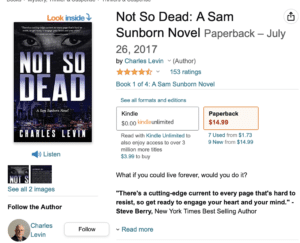
Whereas on desktop, there’s an entire extra sentence that shows before clicking “Read more.”

Inside Amazon, there isn’t really a way to review changes in real time, you’ll have to wait for Amazon to update the changes.
Don’t panic if the changes you make don’t show up right away. In Charles’s experience, sometimes changes will reflect instantly for an ebook version but longer for a paperback or hardcover.
However, if you use HTML, which we’ll cover in the next section, you will have a lot more control over the formatting, with the added ability to edit in real-time.
Charles also recommends only making changes to the book description inside the KDP dashboard, and not in Amazon Author Central.
If you make any changes inside Author Central and then make a change inside KDP for some other reason like updating your cover or manuscript, that change will overwrite any changes you made in Author Central keeping only the last Description you had put directly on the book’s KDP Content page.
Enhanced Elements in Book Descriptions
Amazon allows authors to add elements to their book descriptions, allowing certain items to stand out. authors can add elements such as:
- Bold
- Italics
- Underlines
- Bulleted Lists
- & More!
Charles recommends setting all book titles in italics, as is the industry standard. Use bold text to draw the eye in, making it a great candidate for your hook, blurbs, and calls to action.
Another best practice is to break up the visual of the description by having short paragraphs with breaks and bold mixed throughout.
Amazon Book Descriptions by Genre
As we saw with fiction and non-fiction, book description best practices will also vary by genre.
Klytics has great yearly reports on the bestsellers by genre. If you don’t want to use a paid service, take a look at the best sellers in your genre and view trends inside their book descriptions. There is no shame in taking inspiration from them.
Conclusion
To recap, the formula Charles uses to write his Amazon book description goes as follows:
The Hook – A question that attempts to get the reader or potential purchaser to relate to it or just start thinking.
Follow-Up Blurb – A testimonial blurb adding credibility and social proof.
Book Description – A few paragraphs about the book hinting at the plot and revealing the protagonist.
From here, it varies a little bit depending on if you’re writing fiction or nonfiction
In Fiction
Book & Author Comparisons – Compare your book to similar authors and books
In Nonfiction
Author Credentials – Tell the reader why you’re qualified to write this book and give them advice
The “Why” – What’s so special about this book compared to others?
Call to Action – Both Fiction and Nonfiction end in a similar way, with a strong call to action instructing the reader to buy your book to find out more.
That’s all we have on Amazon book descriptions for now. If you have any questions for Charles or the Booklinker team, be sure to drop a comment and we’ll get back to you quickly.

Introducing: Booklinker Collections
One landing page for all your books. 100% free.
One link for easy sharing of your books across your backmatter, websites, emails, and social media.
Author
-
Charles Levin is the founder of MunnAvenuePress.com a full-service publishing and marketing company. Charlie is an author who has written four thriller novels, NOT SO DEAD, NOT SO GONE, NOT SO DONE, and STILL NOT DEAD. and a collection of 30 short stories called The Last Appointment. His latest Amazon #1 New Release in Children’s Books is Nougo and His Basketball, co-created with his twin grandsons. Charlie’s 27-year background in tech, degree in philosophy, and love of fast-paced thrillers are the brew that created them.
https://charleslevin.com/



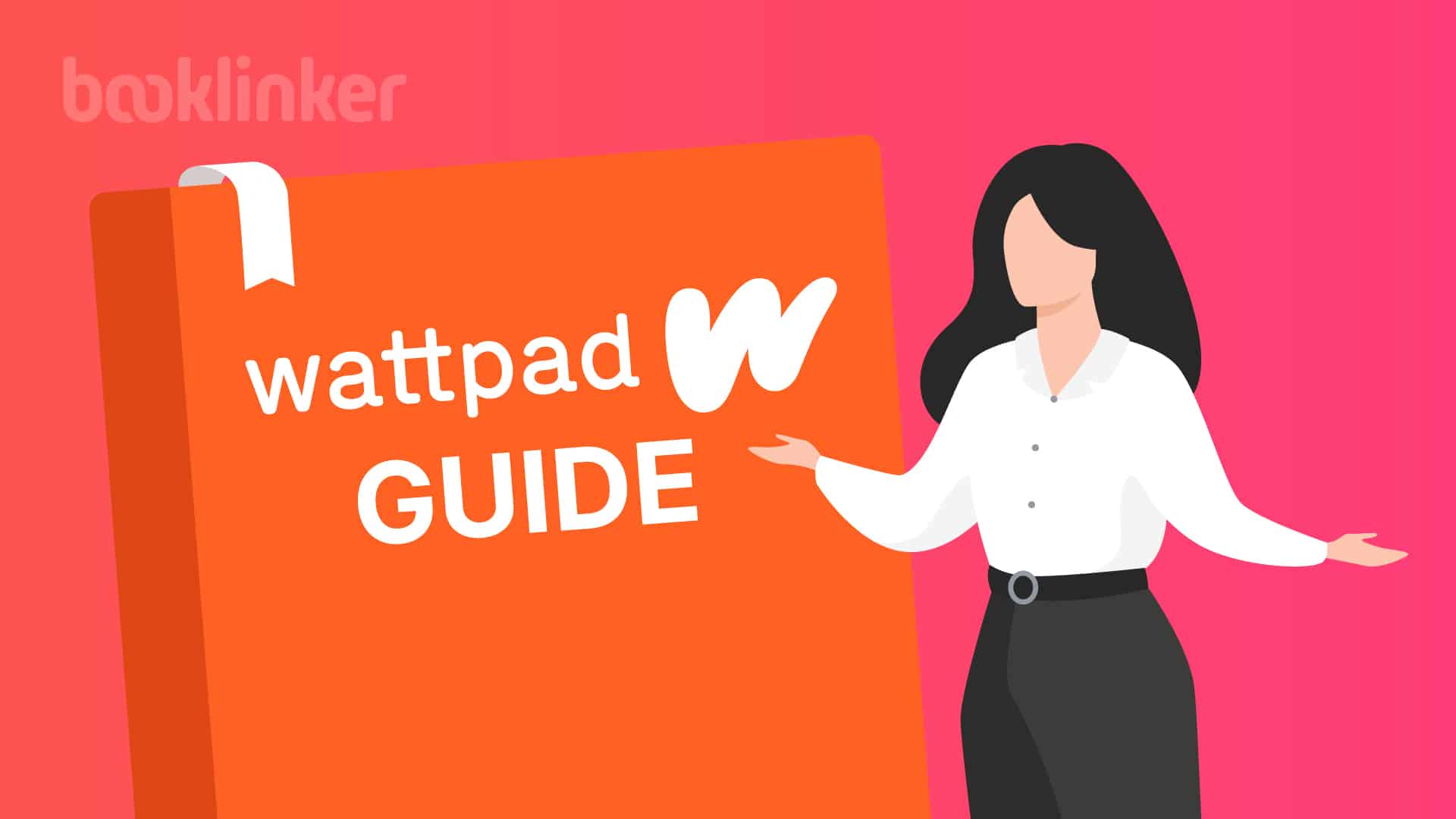
2 Responses
Interesting article, thank you.
However, as of May 2024 Amazon explicitly forbids adding “reviews, quotes, or testimonials” into the book descriptions.
https://kdp.amazon.com/en_US/help/topic/G201097560#description
Hey J.K. thank you for the comment! We’re making a revamp to this post shortly and will edit the post to remove mentions of reviews, quotes, and testimonials!